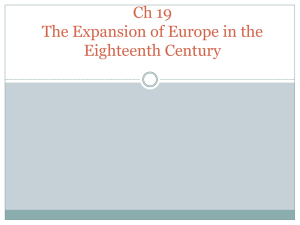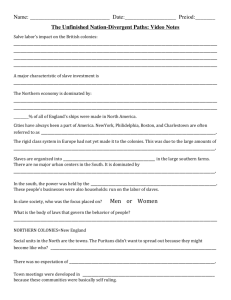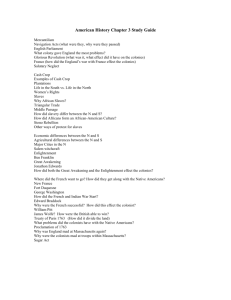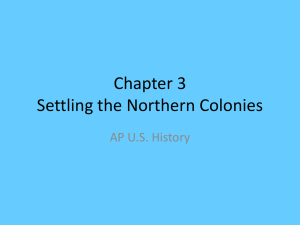Chapter 18 Quiz
advertisement
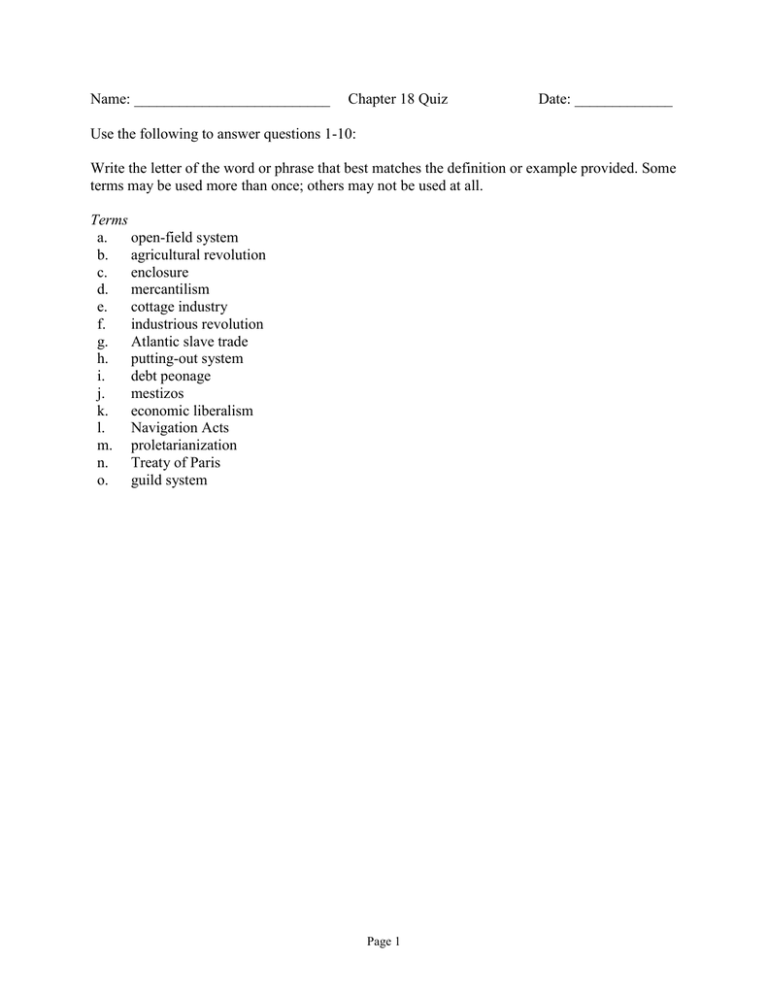
Name: __________________________ Chapter 18 Quiz Date: _____________ Use the following to answer questions 1-10: Write the letter of the word or phrase that best matches the definition or example provided. Some terms may be used more than once; others may not be used at all. Terms a. open-field system b. agricultural revolution c. enclosure d. mercantilism e. cottage industry f. industrious revolution g. Atlantic slave trade h. putting-out system i. debt peonage j. mestizos k. economic liberalism l. Navigation Acts m. proletarianization n. Treaty of Paris o. guild system Page 1 Page 2 1. The organization of artisanal production into trade-based associations, or guilds, each of which received a monopoly over its trade and the right to train apprentices and hire workers. 2. The treaty that ended the Seven Years' War in Europe and the colonies in 1763 and ratified British victory on all colonial fronts. 3. The movement to fence in fields in order to farm more effectively, at the expense of poor peasants who relied on common fields for farming and pasture. 4. The shift that occurred as families in northwestern Europe focused on earning wages instead of producing goods for household consumption; this reduced their economic self-sufficiency but increased their ability to purchase consumer goods. 5. The transformation of large numbers of small peasant farmers into landless rural wage earners. 6. A form of serfdom that allowed a planter or rancher to keep his workers or slaves in perpetual debt bondage by periodically advancing food, shelter, and a little money. 7. A series of English laws that controlled the import of goods to Britain and British colonies. 8. The forced migration of Africans across the Atlantic for slave labor on plantations and in other industries; the trade reached its peak in the eighteenth century and ultimately involved almost twelve million Africans. 9. The period in Europe from the mid-seventeenth through the mid-nineteenth centuries during which great agricultural progress was made and the fallow, or idling of a field to replenish nutrients, was gradually eliminated. 10. A belief in free trade and competition based on Adam Smith's argument that the invisible hand of free competition would benefit all individuals, rich and poor. Page 3 Choose the letter of the best answer. 11. Which of the following best describes the open-field system of the Middle Ages? A) The land was divided into long, narrow strips that were not enclosed by fences or hedges. B) The land was not divided but worked communally as villages labored in large fields side-by-side. C) The land was divided into small, rectangular plots bounded by small walls or fences to keep out animals. D) The land was divided into large, square plots that permitted individual families to retain control over their own crops. E) The land was not divided, so the lord of the manor could directly control agricultural techniques and introduce farming innovations. 12. Which of the following best characterizes the condition of the peasant in Western Europe in the eighteenth century? A) Peasants were bound to a lord's feudal manor and worked the lord's land as part of a long series of feudal obligations. B) Peasants were technically free but suffered under a system of debt obligation to feudal lords that prevented the peasant from owning his own land. C) Peasants were free to own small plots of land but never enough to fully support themselves, requiring them to continue to work the land of the local lord, who owned a vast majority of it. D) A peasant was free to own land, but that land reverted to the noble lord upon the peasant's death. E) Peasants were generally free from serfdom and owned land that they could pass on to their children. 13. In the eighteenth century, the advocates for agricultural innovation argued that A) the rights of the nobility over land needed to be reinforced, since until that time only nobles could force through innovations. B) government officials should seize land in order to demonstrate the value of agricultural innovation so that local farmers would adopt such practices. C) landholdings and common lands needed to be consolidated and enclosed in order to farm more efficiently. D) the key to agricultural innovation was to provide support for the peasants against the lords, since the lords resisted innovation that they feared would diminish their authority. E) farming should be strictly separated from herding for sheep and cattle, since herds diminished the lands' productivity by trodding on and flattening loose soil. Page 4 14. Which of the following correctly characterizes the transformation of the English and Scottish countryside in the enclosure era? A) Land was owned largely by middle-sized farmers who hired the poor as occasional farmers. B) Forced to sell their land following enclosures, most of the nobility left the countryside and moved to the cities. C) The large pools of urban laborers were forced to work in the countryside, for the growing agricultural innovations required more workers for the land. D) The elimination of common rights and access to land turned small peasant farmers into landless wage earners. E) While enclosure affected some land usage, most land remained deeply tied to traditional feudal structures. 15. The English Navigation Acts mandated that all English imports and exports be transported on English ships, and they also A) restricted English banks from making foreign loans. B) initiated English involvement in the transatlantic slave trade. C) gave British merchants a virtual monopoly on trade with British colonies. D) created an alliance with the Dutch against the French. E) prevented the American colonists from building ships. 16. The Englishman Jethro Tull A) demonstrated that slow oxen who produced more manure were preferred for plowing over swifter-moving horses. B) sought to critically analyze farming methods and develop better methods about farming through empirical research. C) promoted the idea of a lost rural past where Englishmen lived in harmony tending their fields. D) became the popular symbol of rural rebellion when he burned his fields rather than enclose them. E) became the first non-noblemen to be England's largest landowner, with vast estates in southeastern England. 17. Throughout the sixteenth and seventeenth centuries, armies affected population growth in all of the following ways except A) soldiers and camp followers passed contagious diseases throughout the countryside. B) a large number of individuals were killed on the battlefield. C) armies requisitioned scarce food supplies. D) armies disrupted the agricultural cycle. E) battles destroyed precious crops and farmland. Page 5 18. Population growth in Europe in the eighteenth century A) only occurred in a few regions that were able to avoid warfare. B) occurred primarily in regions that saw substantial agricultural innovations. C) occurred primarily in prosperous regions that were establishing colonial lands in Asia and the Americas. D) occurred largely in Eastern Europe where the stability of the feudal system aided population growth. E) occurred in all regions. 19. How did the problem of food shortages change in the eighteenth century? A) The considerable road and canal building of the eighteenth century permitted food to be more easily transported to regions with local crop failure and famine. B) The decline in warfare meant that armies no longer drained regions of their food supplies as they passed through and no longer destroyed many crops. C) The advances in agricultural methods produced abundant food that overcame the possibility of famine. D) The free grain markets introduced throughout the eighteenth century evened out food distribution to prevent food shortages without government involvement. E) The European colonies became an alternate source for food that could be used to overcome poor harvests. 20. The leadership of the Dutch people in farming methodology can be attributed primarily to A) the exceptional fertility of their lands. B) the necessity to provide for a densely populated country. C) the leadership of the Dutch scientific community. D) their strong nobility. E) their Calvinism. 21. The rural putting-out system had all of the following competitive advantages except A) Underemployed labor was abundant, and the poor worked for low wages. B) Production in the countryside was unregulated. C) Lacking guild standards, workers could produce a wide variety of goods. D) Merchants could change procedures and experiment. E) The workers had to purchase the raw material themselves, saving the merchant capital expenses. 22. Within the family, the operation of the loom A) was somewhat dangerous, and children were forbidden from helping with it. B) generally only occupied one person, leaving other family members to farm or seek outside employment. C) was considered a man's job, reserved for the male head of household. D) required extensive training and kept the loom operator away from home for two to three years. E) was considered a woman's job, as were most of the sewing crafts. Page 6 23. The spinning of thread for the loom A) required the work of several spinners for each loom, which led merchants to employ the wives and daughters of agricultural workers at terribly low wages. B) was established as a unique craft in which communities and even regions specialized, especially those regions that practiced the herding of large flocks of sheep. C) was quickly turned into a mechanized process, which freed more women to take up operation of the loom. D) required a difficult set of skills that men came to monopolize and used to earn higher salaries than women, who were left the simple task of spooling the thread. E) marked a new type of industry in which the merchants created unambiguous standards for spun thread that reduced conflicts between merchants and spinners. 24. The idea of the industrious revolution is best understood as a result of A) the reduction of holidays and festivals by the state in order to create more workdays during the year, combined with laws requiring the closing of taverns two hours past sunset. B) efforts by Protestant and Catholic churches to combat sin by promoting a gospel of prosperity and industry that would keep workers productively at their labors. C) merchant capitalists gaining greater authority over workers and forcing them into factories where their work activity could be more closely monitored and controlled. D) poor families choosing to reduce leisure time and the production of goods for household consumption in order to earn wages to be used to buy consumer goods. E) the nobility expanding its land holdings by draining swamps and fens, which required workers to provide labor for their noble lords. 25. Which of the following best describes the role of women in guilds in the eighteenth century? A) Guilds dropped all restrictions that forbade women from serving as masters or laborers. B) Both legal and illegal work in guilds became more accessible to women. C) Guilds permitted women to serve as workers but forbade any women from becoming masters. D) Guilds promoted middle-class ideals about the harm to women of working outside of the home. E) Guilds reinforced the regulations forbidding all work by and mastership for women. Page 7 26. At the center of Adam Smith's arguments in The Wealth of Nations was the belief that A) the pursuit of self-interest in competitive markets would improve the living conditions of the citizens. B) capitalism could only flourish if workers' wages were kept low. C) government was incapable of providing services as efficiently as the free marketplace. D) guilds provided a structural stability to the economy that permitted the free market to function effectively. E) the government had a responsibility to protect consumers and the general public from price gouging and fraud. 27. From 1701 to 1763, what was at stake in the warfare between Great Britain and France? A) The position as Europe's leading maritime power with the ability to claim profits from Europe's overseas expansion B) The ability of each to establish effective systems to supply expanding militaries C) The preeminent position in continental Europe with the ability to shape domestic policy in many nations D) The control over slave trade routes to support colonial development in the Caribbean E) The establishment of either absolutism or constitutional monarchy as the principle political model in Europe 28. The War of the Austrian Succession could best be described as A) a strong Prussian victory that undermined the role of Austria in German affairs. B) a distinct French victory that forced Britain to abandon its last remaining land claims on the continent. C) a clear British victory that forced the French to retreat from North America. D) an Austrian victory that forced Prussia to abandon much to its territory. E) an inconclusive standoff that set the stage for further warfare. 29. The British won the American component of the Seven Years' War because A) the French military leadership was ineffective. B) their Prussian ally won the European component. C) the French did not have an adequate navy. D) they diverted men and money from Europe to the American theater. E) they won the support of Native American tribes. Page 8 30. Which of the following correctly characterizes eighteenth-century colonial trade in Europe? A) England's exports to its colonies relied heavily on cultural objects such as books and furniture, since the colonies produced all of their own basic needs. B) Colonial trade became insignificant to the French after the loss of their colonies in New France (Canada). C) The Spanish empire collapsed, for Spain lacked the resources to sustain its military presence in the colonies. D) Spanish landowners in the colonies instituted slavery among all the Indian populations in order to force them to work on the haciendas. E) In England, the mercantilist system achieved remarkable success as British trade with its colonies grew substantially. 31. Which of the following best characterizes the regions to which slaves were carried from Africa to the Americas? A) About 90 percent of slaves were transported to Brazil or the Caribbean, with only 3 percent brought to North America. B) Brazil received about one-half of the slaves carried across the Atlantic, while the Caribbean and North America each received about 25 percent. C) The Spanish colonies of South America received about 35 percent of slaves from Africa, while Brazil received about 15 percent and the Caribbean and North America each received about 25 percent. D) The Caribbean received about 50 percent of the slaves, while North America and Spanish South America received about 25 percent each. E) The North American colonies received about 40 percent of slaves from Africa, while Brazil and South America received about 25 percent each and Spanish South America received about 10 percent. 32. In Africa, the slave trade primarily resulted in A) greater prosperity and a growing population. B) more wars and likely fewer people. C) more consumer goods and greater prosperity. D) larger empires and more wars. E) larger empires and far fewer people. Page 9 33. Christianity in colonial societies in the Americas A) remained almost exclusively connected to European colonists, for few native people adopted the religion. B) took on distinctive characteristics through a complex process of cultural exchange that made Christianity more comprehensible to indigenous peoples. C) sought to reestablish medieval traditions and practices in a romantic notion of the faithful Middle Ages. D) remained a foundation of European culture and tradition on which European settlers could depend to defend traditional European practices. E) so fully embraced native customs and traditions that European Christians came to consider the Christianity practiced in the Americas to be heretical. 34. Why did the Dutch fail to maintain their dominance in Asia? A) The Dutch East India Company failed to diversify its trade to meet changing consumption patterns in Europe. B) The Dutch government found that sustaining the colonies in Asia cost more than the profits that could be made and withdrew military protection. C) The Dutch Reformed Church took a position condemning colonialism as sinful, undercutting popular support for the Asian colonies. D) The Dutch economy was devastated by wars with Great Britain and France and lacked capital for continued colonization. E) The Dutch missionaries forcefully pressed Christianity onto local leaders, leading to successful rebellions against the colonies. 35. Who provided the labor force for Britain's initial colonization of Australia? A) Convicted prisoners B) Indentured servants C) Slaves D) Aboriginal people E) Volunteer settlers Page 10 Answer each question with three or four sentences. 36. How did the enclosure movement alter land use patterns? 37. How did the putting-out system function and how did its structures change as industry expanded? 38. What is meant by the idea of the industrious revolution? 39. How did European colonists in the Americas form new views of their place in the world? Page 11 Answer ONE of the following questions in a few paragraphs. Include specific examples that support your thesis and conclusions. 40. During the eighteenth century, the population of Europe underwent a sharp increase. What factors influenced that growth? What were the social consequences of population expansion? 41. What were the most important elements of the agricultural revolution in Europe in the seventeenth and eighteenth centuries? What factors explain the Dutch leadership in this revolution? Why and how did it spread to England? Page 12
